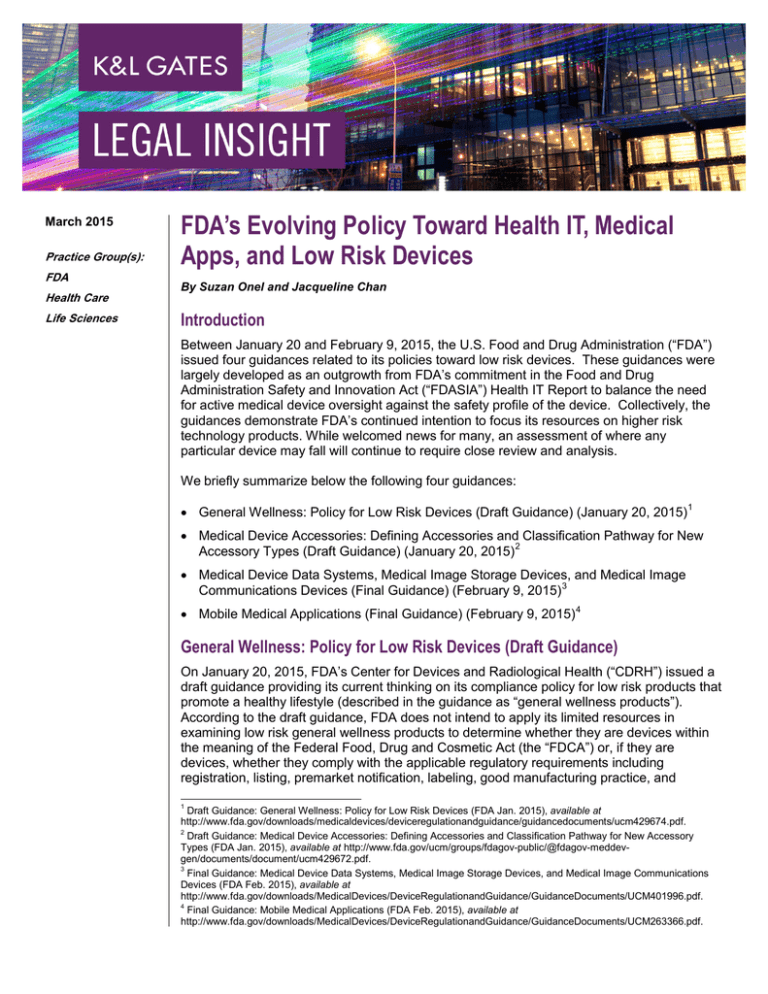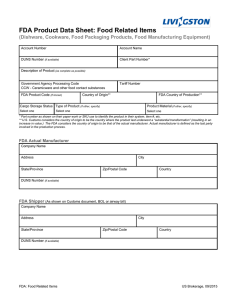
March 2015
Practice Group(s):
FDA
Health Care
Life Sciences
FDA’s Evolving Policy Toward Health IT, Medical
Apps, and Low Risk Devices
By Suzan Onel and Jacqueline Chan
Introduction
Between January 20 and February 9, 2015, the U.S. Food and Drug Administration (“FDA”)
issued four guidances related to its policies toward low risk devices. These guidances were
largely developed as an outgrowth from FDA’s commitment in the Food and Drug
Administration Safety and Innovation Act (“FDASIA”) Health IT Report to balance the need
for active medical device oversight against the safety profile of the device. Collectively, the
guidances demonstrate FDA’s continued intention to focus its resources on higher risk
technology products. While welcomed news for many, an assessment of where any
particular device may fall will continue to require close review and analysis.
We briefly summarize below the following four guidances:
• General Wellness: Policy for Low Risk Devices (Draft Guidance) (January 20, 2015)1
• Medical Device Accessories: Defining Accessories and Classification Pathway for New
Accessory Types (Draft Guidance) (January 20, 2015) 2
• Medical Device Data Systems, Medical Image Storage Devices, and Medical Image
Communications Devices (Final Guidance) (February 9, 2015) 3
• Mobile Medical Applications (Final Guidance) (February 9, 2015) 4
General Wellness: Policy for Low Risk Devices (Draft Guidance)
On January 20, 2015, FDA’s Center for Devices and Radiological Health (“CDRH”) issued a
draft guidance providing its current thinking on its compliance policy for low risk products that
promote a healthy lifestyle (described in the guidance as “general wellness products”).
According to the draft guidance, FDA does not intend to apply its limited resources in
examining low risk general wellness products to determine whether they are devices within
the meaning of the Federal Food, Drug and Cosmetic Act (the “FDCA”) or, if they are
devices, whether they comply with the applicable regulatory requirements including
registration, listing, premarket notification, labeling, good manufacturing practice, and
1
Draft Guidance: General Wellness: Policy for Low Risk Devices (FDA Jan. 2015), available at
http://www.fda.gov/downloads/medicaldevices/deviceregulationandguidance/guidancedocuments/ucm429674.pdf.
2
Draft Guidance: Medical Device Accessories: Defining Accessories and Classification Pathway for New Accessory
Types (FDA Jan. 2015), available at http://www.fda.gov/ucm/groups/fdagov-public/@fdagov-meddevgen/documents/document/ucm429672.pdf.
3
Final Guidance: Medical Device Data Systems, Medical Image Storage Devices, and Medical Image Communications
Devices (FDA Feb. 2015), available at
http://www.fda.gov/downloads/MedicalDevices/DeviceRegulationandGuidance/GuidanceDocuments/UCM401996.pdf.
4
Final Guidance: Mobile Medical Applications (FDA Feb. 2015), available at
http://www.fda.gov/downloads/MedicalDevices/DeviceRegulationandGuidance/GuidanceDocuments/UCM263366.pdf.
FDA’s Evolving Policy Toward Health IT, Medical Apps, and Low Risk Devices
medical device reporting. The draft guidance defines general wellness products as products
that meet two criteria: (1) the product is intended only for general wellness use (as defined
by the guidance) and (2) the product presents a very low risk to the safety of its user. For
the product to have a general wellness use, the product must have either an intended use
that relates to maintaining or encouraging a healthy lifestyle or one that connects the role of
a healthy lifestyle to reducing the risk or impact of certain chronic illnesses. According to the
draft guidance, the general wellness policy does not extend to devices that are invasive,
involve an intervention or technology that may pose a risk to a user’s safety if device controls
are not applied, raise novel questions of usability, or raise questions of biocompatibility.
This is a very interesting guidance and may provide significant relief for devices that meet
the general wellness product definition. However, as industry and FDA move forward with
trying to implement this draft guidance, we anticipate significant uncertainty due to the lack of
clarity surrounding the terms “general wellness use” and “very low risk to the safety of the
user.” Comments on this guidance are being accepted through April 20, 2015.
Medical Device Accessories: Defining Accessories and Classification Pathway
for New Accessory Types (Draft Guidance)
On January 20, 2015, FDA issued a draft guidance on medical device accessories.
Typically, a device accessory is regulated either under its own classification (if a regulation
has been issued for it) or under the same classification as its parent device (e.g., Class I, II,
or III). Historically, this approach has posed difficulties for device accessories with lower risk
profiles than their parent device because they were nevertheless included in the same
regulatory classification as the parent. FDA’s draft guidance formally acknowledges this
dichotomy and specifically states its intention to apply a risk-based approach to the
classification of device accessories.
The draft guidance begins well by providing a definition of “accessory” and “parent device”
and describing its classification policy as applied to device accessories. FDA defines an
accessory as “a device that is intended to support, supplement, and/or augment the
performance of one or more parent devices.” 5 It defines a parent device as “a finished
device whose performance is supported, supplemented, and/or augmented by one or more
accessories.” 6 However, the draft guidance falls short in advising companies how to
proceed since the only pathway discussed is the de novo classification process under FDCA
513(f)(2), which only applies to new low risk devices that have no legally marketed predicate
device.
The guidance leaves unanswered what steps companies should take if they have a low risk
device accessory that does not meet the “new” definition. Comments may be submitted
regarding this draft guidance through April 20, 2015.
Medical Device Data Systems, Medical Image Storage Devices, and Medical
Image Communications Devices (Final Guidance)
On February 9, 2015, FDA issued a final guidance on medical device data systems
(“MDDS”), medical image storage devices, and medical image communications devices,
5
6
Medical Device Accessories Draft Guidance at 4.
Id.
2
FDA’s Evolving Policy Toward Health IT, Medical Apps, and Low Risk Devices
reaffirming its intention not to enforce regulatory compliance against devices meeting these
regulatory definitions. Under 21 CFR 880.6310, an MDDS is a device “intended to provide
one or more of the following uses, without controlling or altering the functions or parameters
of any connected medical devices: (i) the electronic transfer of medical device data; (ii) the
electronic storage of medical device data; (iii) the electronic conversion of medical device
data from one format to another format in accordance with a preset specification; or (iv) the
electronic display of medical device data.” MDDS does not include devices that (i) are
intended to be used in connection with active patient monitoring;7 (ii) modify the medical
device data; or (iii) control the functions or parameters of any connected medical device.
The final guidance confirmed FDA’s intent to exercise enforcement discretion to not enforce
compliance with the FDCA’s statutory and regulatory requirements for devices that meet the
definition of an MDDS (21 CFR 880.6310), a medical image storage device (21 CFR
892.2010), or a medical image communications device (21 CFR 892.2020). In other words,
according to FDA’s final guidance, these devices are not required to register, list, or comply
with quality systems regulations or medical device reporting or recall requirements. This is
consistent with FDA’s draft MDDS guidance, which was issued on June 20, 2014. While the
regulations have not been rescinded and guidance documents do not have the force of law,
the guidance document reflects FDA’s current thinking on the matter.
Mobile Medical Applications (Final Guidance)
On February 9, 2015, FDA issued a final guidance regarding mobile medical applications
(“mobile apps”). This guidance supersedes the final mobile medical applications guidance
previously issued on September 25, 2013. The guidance was updated to be consistent with
and reflect the MDDS final guidance issued on the same day. For instance, FDA adds
mobile apps that meet the definition of MDDS as an example of a mobile app for which FDA
intends to exercise enforcement discretion. Beyond issuing the final guidance document,
FDA will continue to update its website with illustrative examples of mobile apps that it does
not consider to be medical devices, mobile apps for which it intends to exercise enforcement
discretion, and mobile apps that remain the focus of its regulatory oversight. 8
Conclusion
Collectively, these four guidances reflect FDA’s intent to implement a more closely calibrated
risk-based approach to general wellness products, device accessories, medical device data
systems, and related medical image storage and communication devices. While clearly
welcomed news, we strongly encourage companies to review these guidances closely to
understand their scope and limitations.
If you have questions regarding the regulatory requirements that may apply to a particular
device or would like to submit comments to the draft guidances, we would be pleased to
assist.
7
As FDA explained in the preamble to the MDDS regulation, “active” represents “any device that is intended to be relied
upon in deciding to take immediate clinical action.”
8
FDA Mobile Medical Applications, available at
http://www.fda.gov/MedicalDevices/ProductsandMedicalProcedures/ConnectedHealth/MobileMedicalApplications/default.
htm.
3
FDA’s Evolving Policy Toward Health IT, Medical Apps, and Low Risk Devices
Authors:
Suzan Onel
suzan.onel@klgates.com
+1.202.778.9134
Jacqueline Chan
jacqueline.chan@klgates.com
+1.202.778.9291
Anchorage Austin Beijing Berlin Boston Brisbane Brussels Charleston Charlotte Chicago Dallas Doha Dubai Fort Worth Frankfurt
Harrisburg Hong Kong Houston London Los Angeles Melbourne Miami Milan Moscow Newark New York Orange County Palo Alto Paris
Perth Pittsburgh Portland Raleigh Research Triangle Park San Francisco São Paulo Seattle Seoul Shanghai Singapore Spokane
Sydney Taipei Tokyo Warsaw Washington, D.C. Wilmington
K&L Gates comprises more than 2,000 lawyers globally who practice in fully integrated offices located on five
continents. The firm represents leading multinational corporations, growth and middle-market companies, capital
markets participants and entrepreneurs in every major industry group as well as public sector entities, educational
institutions, philanthropic organizations and individuals. For more information about K&L Gates or its locations,
practices and registrations, visit www.klgates.com.
This publication is for informational purposes and does not contain or convey legal advice. The information herein should not be used or relied upon in
regard to any particular facts or circumstances without first consulting a lawyer.
© 2015 K&L Gates LLP. All Rights Reserved.
4





